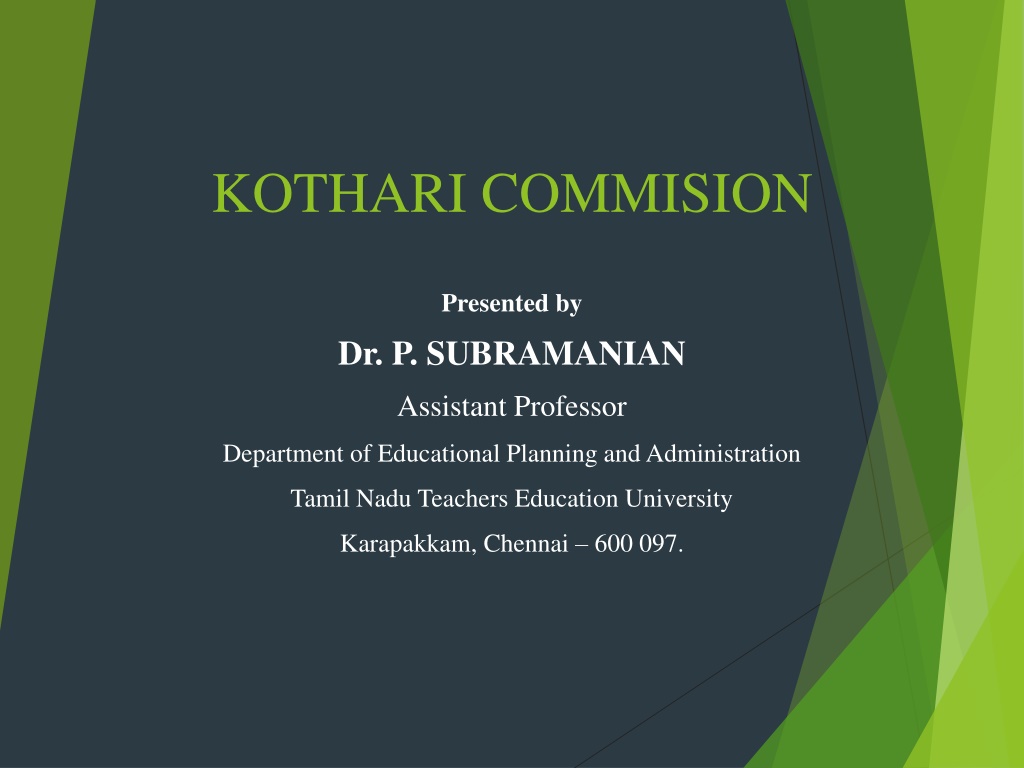Overview of Kothari Commission's Educational Recommendations
The Kothari Commission, led by Dr. D.S. Kothari, was appointed in 1964 to advise the Indian government on national education development. The commission focused on qualitative improvements and quantitative expansion of education, emphasizing the importance of teacher training, curriculum development, guidance, and equal educational opportunities. It aimed to align education with productivity, national integration, democracy, and modernization while nurturing values and character building. The commission also proposed a structured approach to education, outlining the interdependencies among various educational stages, teacher quality, curriculum design, teaching methods, and infrastructure utilization.
Download Presentation

Please find below an Image/Link to download the presentation.
The content on the website is provided AS IS for your information and personal use only. It may not be sold, licensed, or shared on other websites without obtaining consent from the author. Download presentation by click this link. If you encounter any issues during the download, it is possible that the publisher has removed the file from their server.
E N D
Presentation Transcript
KOTHARI COMMISION Presented by Dr. P. SUBRAMANIAN Assistant Professor Department of Educational Planning and Administration Tamil Nadu Teachers Education University Karapakkam, Chennai 600 097.
INTRODUCTION The National Education Commission was appointed in 1964 and it reported in 1966. Its chairman was Dr. D. S. Kothari, Chairman, University Grants Commission. The terms of reference were to advice government on national education and on the general principles and policies for the development of education at all stages and all its aspects. pattern of
SALIENT FEATURES OF KOTHARI COMMISSION The recommendations laid down aims of education economic, political, emotional, social, scientific, and personal. It recommended qualitative improvements and quantitative expansion. Educational pyramid was to be built from pre- primary to the university levels.
Professional considered improvement of education. preparation crucial of teachers the was to qualitative Salary scales were fixed and improved. Curriculum was laid down from pre-primary to university stages. New teaching methods were to be used.
Guidance and counseling were to be the integral part of education. Recommendations were made to ensure equality in educational between male and female population and between advanced and backward sections of society. opportunities Work experience was recommended for students at all levels.
NATIONAL AIMS Education was to be related to productivity and national integration. It was to strengthen social integration and consolidate democracy as a form of government and help the country to adopt it as a way of life. It was to hasten the process of modernization. It was to strive to build character by activation of social, moral and spiritual values.
STRUCTURE OF EDUCATION It was recommended that the educational pyramid required division into interrelationship, stages and their the duration of different stages, the quality of teachers, Curriculum, Methods of teaching and evaluation equipment and building and utilization of available facilities.
STRUCTURE OF PRIMARY EDUCATION Pre-primary education pre-primary, pre- basic, kindergarten, Montessori. Primary education class I to VII or I to VIII which included lower primary classes (I IV) or (I to V) in some States, lower primary in some other states and lower elementary still in some states. Higher primary education Classes V-VII or VI VIII.
LOWER PRIMARY STAGE (CLASS I IV) One language the mother tongue or the regional language Mathematics Study of environment (covering science and social studies in class III or IV) Creative activities Work experience and social service Health education
HIGHER PRIMARY STAGE (CLASS V-VIII) Two languages Mother tongue or the regional language Hindi or English A third language (English, Hindi, or the regional language) might be studied on an optional basis. Mathematics Science Social studies Art or craft Work experience Physical education Education in moral and spiritual values
LOWER SECONDARY STAGE (CLASS IX- X) Three languages Mathematics Science History, geography and civics Art and craft Work experience and social service Physical education Education in moral and spiritual values
HIGHER SECONDARY STAGE (CLASS XI XII) Any two languages, including any modern Indian language, any modern foreign language and any classical language An additional language History Geography Economics Logic Psychology Sociology Art Physics Chemistry Mathematics Biology Geology Home science Work experience and social services Physical education Art or craft Education in moral and spiritual values.
The commission recommended that tuition fees at the primary level were to be abolished. Lower secondary education was to be free before the end of the fifth plan. At primary level, free text books and working material were to be provided. At the primary stage, scholarships were to be awarded to a needy child
Education for the scheduled castes was to be expanded. Bold and determined efforts were to be made for the education of women. Work experience might be considered an innovation of the commission.
CONCLUSION The commission recommended fewer holidays, increase in working hours, decrease in examination days, and home work in long holidays and self study by using libraries, reading rooms, laboratories and workshops etc.
REFERENCES Dutt, B. & Garg, Jyoti. (2012). Educational Planning and administration. New Delhi: Global Publications. Mathur, S. S. (1990). Educational administration and management. India: The Indian Publications. Ministry of Education. (1966). Report of the education commission (1964-66): Education and national development. New Delhi: Govt. of India.

 undefined
undefined
























